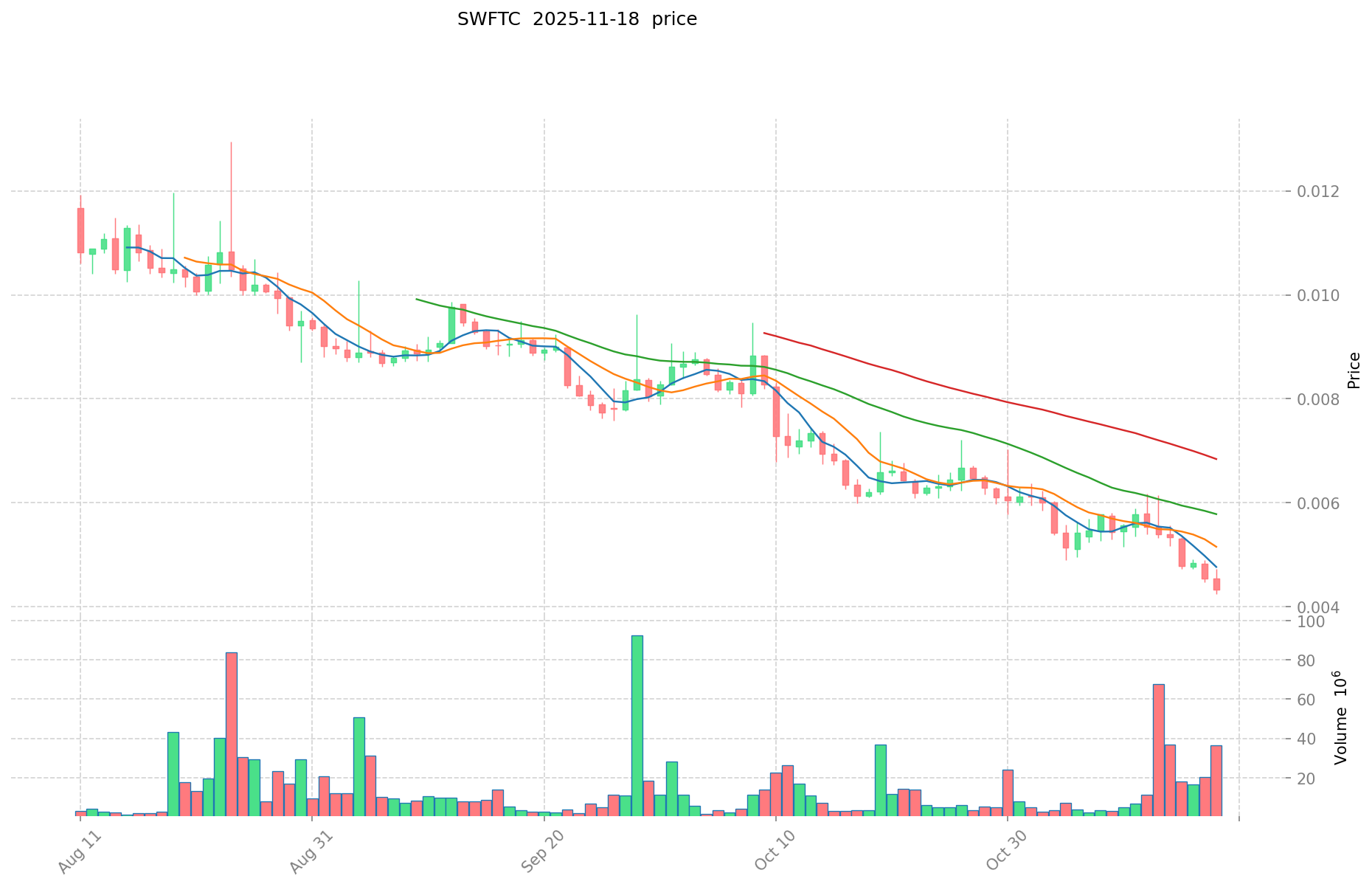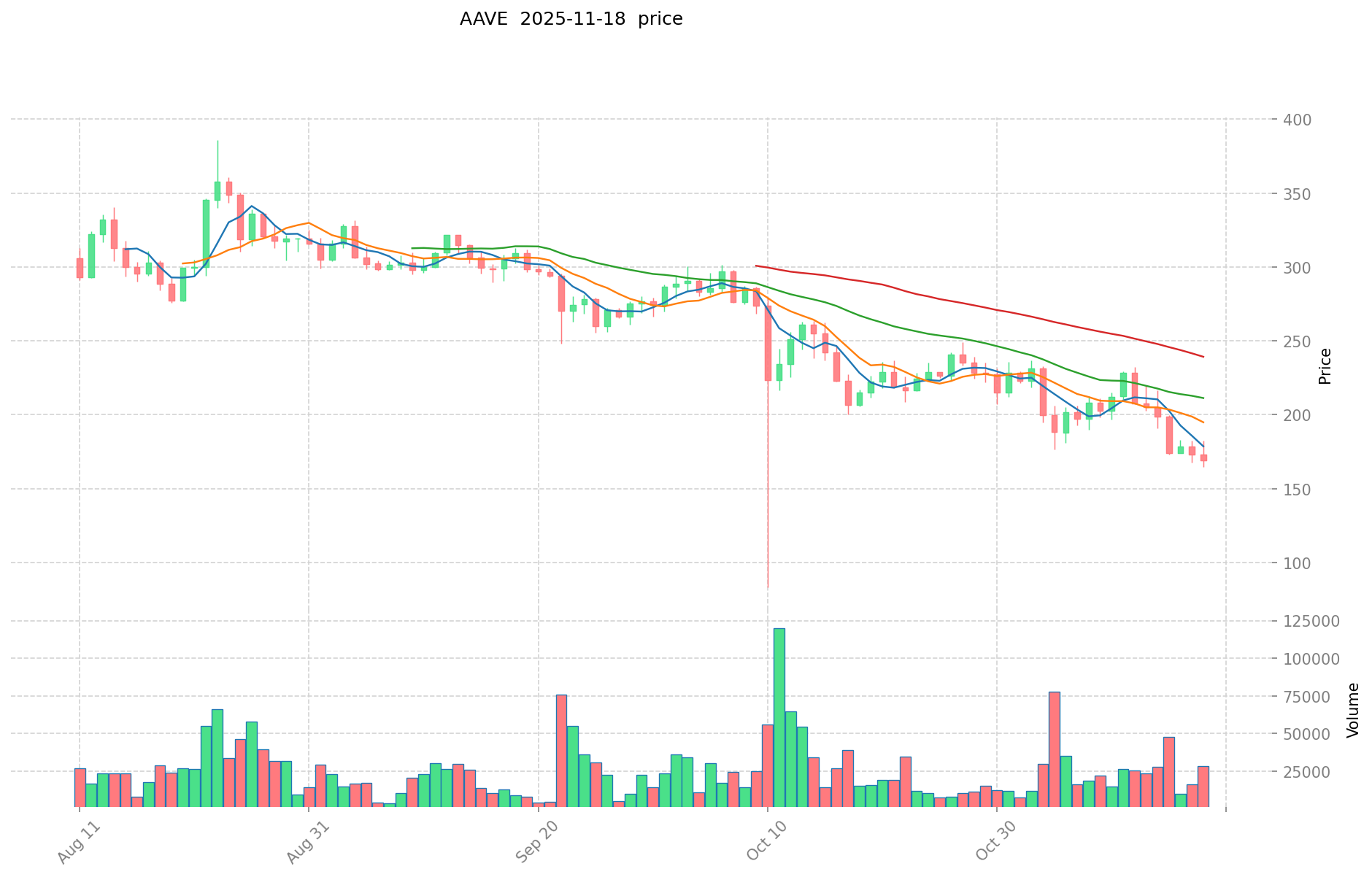SWFTC vs AAVE: Comparing Two DeFi Protocols for Yield Farming and Liquidity Provision
Introduction: SWFTC vs AAVE Investment Comparison
In the cryptocurrency market, the comparison between SWFTC and AAVE has always been a topic that investors cannot avoid. The two not only have significant differences in market cap ranking, application scenarios, and price performance, but also represent different positioning in the crypto asset space.
SWFTC (SWFTC): Since its launch in 2018, it has gained market recognition for its AI-powered blockchain ecosystem and cross-chain transaction capabilities.
AAVE (AAVE): Introduced in 2020, it has been hailed as a leading decentralized lending protocol, becoming one of the most traded and highly valued cryptocurrencies globally.
This article will comprehensively analyze the investment value comparison between SWFTC and AAVE, focusing on historical price trends, supply mechanisms, institutional adoption, technological ecosystems, and future predictions, attempting to answer the question most concerning to investors:
"Which is the better buy right now?"
I. Price History Comparison and Current Market Status
SwftCoin (SWFTC) and AAVE (AAVE) Historical Price Trends
- 2020: AAVE launched through the improvement proposal (AIP1), converting LEND to AAVE at a 100:1 ratio on October 3, 2020.
- 2021: AAVE reached its all-time high of $661.69 on May 19, 2021, during the bull market.
- Comparative analysis: SWFTC's all-time high was $0.04665833 on February 1, 2025, while its all-time low was $0.00046438 on March 13, 2020. AAVE has shown a wider price range, with an all-time low of $26.02 on November 5, 2020.
Current Market Situation (2025-11-18)
- SWFTC current price: $0.004212
- AAVE current price: $168.25
- 24-hour trading volume: SWFTC $208,942.11 vs AAVE $5,084,486.27
- Market Sentiment Index (Fear & Greed Index): 11 (Extreme Fear)
Click to view real-time prices:
- Check SWFTC current price Market Price
- Check AAVE current price Market Price


II. Core Factors Affecting Investment Value of SWFTC vs AAVE
Supply Mechanisms Comparison (Tokenomics)
-
SWFTC: Fixed total supply of 10 billion tokens with no inflation mechanism
-
AAVE: Dynamic supply model with staking rewards and governance mechanisms
-
📌 Historical Pattern: Fixed supply tokens like SWFTC typically experience higher volatility during market cycles, while AAVE's economic model with staking rewards tends to encourage long-term holding during market fluctuations.
Institutional Adoption and Market Applications
- Institutional Holdings: AAVE has gained significant institutional interest as a leading DeFi protocol, while SWFTC has limited institutional presence
- Enterprise Adoption: AAVE's lending protocol is widely used across the DeFi ecosystem for yield generation and liquidity provision; SWFTC's cross-chain atomic swap technology has more limited enterprise integration
- Regulatory Attitudes: DeFi protocols like AAVE face increasing regulatory scrutiny in various jurisdictions, while SWFTC's lower profile has resulted in less regulatory attention
Technical Development and Ecosystem Building
- SWFTC Technical Upgrades: Focusing on cross-chain asset swaps and exchange services with limited recent technical advancements
- AAVE Technical Development: Continuous innovation with protocol upgrades, including Aave V3 with enhanced capital efficiency, risk management, and cross-chain capabilities
- Ecosystem Comparison: AAVE has a robust DeFi ecosystem with lending markets across multiple chains, liquidity mining programs, and strong developer community; SWFTC has a more limited ecosystem primarily focused on its exchange services
Macroeconomic Factors and Market Cycles
- Performance in Inflationary Environments: AAVE tends to benefit from DeFi demand during inflationary periods as users seek yield opportunities; SWFTC shows less correlation with inflation trends
- Macroeconomic Monetary Policy: Interest rate hikes typically pressure both tokens, but AAVE's yield-generating capabilities may provide some offset during tightening cycles
- Geopolitical Factors: Cross-border transaction demand can benefit both platforms, though AAVE's broader utility in the DeFi ecosystem provides more resilience to regional disruptions
III. 2025-2030 Price Prediction: SWFTC vs AAVE
Short-term Prediction (2025)
- SWFTC: Conservative $0.003162 - $0.004216 | Optimistic $0.004216 - $0.00552296
- AAVE: Conservative $152.622 - $169.58 | Optimistic $169.58 - $213.6708
Mid-term Prediction (2027)
- SWFTC may enter a growth phase, with an estimated price range of $0.003241125888 - $0.00582389808
- AAVE may enter a volatile market, with an estimated price range of $118.9993734 - $328.3501229
- Key drivers: Institutional capital inflow, ETF, ecosystem development
Long-term Prediction (2030)
- SWFTC: Base scenario $0.005534112812548 - $0.007478530827768 | Optimistic scenario $0.007478530827768 - $0.007927242677434
- AAVE: Base scenario $252.981561240216 - $316.22695155027 | Optimistic scenario $316.22695155027 - $335.2005686432862
Disclaimer
SWFTC:
| 年份 | 预测最高价 | 预测平均价格 | 预测最低价 | 涨跌幅 |
|---|---|---|---|---|
| 2025 | 0.00552296 | 0.004216 | 0.003162 | 0 |
| 2026 | 0.0052590384 | 0.00486948 | 0.003165162 | 15 |
| 2027 | 0.00582389808 | 0.0050642592 | 0.003241125888 | 20 |
| 2028 | 0.0076761508824 | 0.00544407864 | 0.0045730260576 | 29 |
| 2029 | 0.008396946894336 | 0.0065601147612 | 0.005444895251796 | 55 |
| 2030 | 0.007927242677434 | 0.007478530827768 | 0.005534112812548 | 77 |
AAVE:
| 年份 | 预测最高价 | 预测平均价格 | 预测最低价 | 涨跌幅 |
|---|---|---|---|---|
| 2025 | 213.6708 | 169.58 | 152.622 | 0 |
| 2026 | 249.11302 | 191.6254 | 182.04413 | 13 |
| 2027 | 328.3501229 | 220.36921 | 118.9993734 | 30 |
| 2028 | 285.334053108 | 274.35966645 | 181.077379857 | 63 |
| 2029 | 352.60704332154 | 279.846859779 | 260.25757959447 | 66 |
| 2030 | 335.2005686432862 | 316.22695155027 | 252.981561240216 | 87 |
IV. Investment Strategy Comparison: SWFTC vs AAVE
Long-term vs Short-term Investment Strategies
- SWFTC: Suitable for investors focused on cross-chain transactions and exchange services
- AAVE: Suitable for investors seeking DeFi exposure and yield opportunities
Risk Management and Asset Allocation
- Conservative investors: SWFTC: 20% vs AAVE: 80%
- Aggressive investors: SWFTC: 40% vs AAVE: 60%
- Hedging tools: Stablecoin allocation, options, cross-currency portfolios
V. Potential Risk Comparison
Market Risk
- SWFTC: Higher volatility due to lower market cap and trading volume
- AAVE: Exposure to broader DeFi market fluctuations and liquidity risks
Technical Risk
- SWFTC: Scalability, network stability
- AAVE: Smart contract vulnerabilities, protocol upgrades
Regulatory Risk
- Global regulatory policies may have a more significant impact on AAVE due to its prominence in the DeFi space
VI. Conclusion: Which Is the Better Buy?
📌 Investment Value Summary:
- SWFTC advantages: Cross-chain capabilities, potential for growth in emerging markets
- AAVE advantages: Established DeFi protocol, institutional adoption, continuous innovation
✅ Investment Advice:
- New investors: Consider AAVE for its established position in DeFi
- Experienced investors: Balanced portfolio with both SWFTC and AAVE
- Institutional investors: Focus on AAVE due to its market prominence and liquidity
⚠️ Risk Warning: Cryptocurrency markets are highly volatile. This article does not constitute investment advice. None
VII. FAQ
Q1: What are the key differences between SWFTC and AAVE? A: SWFTC focuses on cross-chain atomic swaps and exchange services, while AAVE is a leading decentralized lending protocol in the DeFi space. AAVE has a larger market cap, higher trading volume, and more institutional adoption compared to SWFTC.
Q2: Which token has shown better historical price performance? A: AAVE has demonstrated a wider price range and higher all-time high compared to SWFTC. AAVE reached its all-time high of $661.69 on May 19, 2021, while SWFTC's all-time high was $0.04665833 on February 1, 2025.
Q3: How do the supply mechanisms of SWFTC and AAVE differ? A: SWFTC has a fixed total supply of 10 billion tokens with no inflation mechanism. AAVE, on the other hand, employs a dynamic supply model with staking rewards and governance mechanisms.
Q4: Which token is more suitable for long-term investment? A: AAVE is generally considered more suitable for long-term investment due to its established position in the DeFi ecosystem, continuous technical development, and broader utility. However, the choice depends on individual investment goals and risk tolerance.
Q5: What are the main risks associated with investing in SWFTC and AAVE? A: For SWFTC, main risks include higher volatility, scalability issues, and limited ecosystem growth. AAVE faces risks such as exposure to broader DeFi market fluctuations, smart contract vulnerabilities, and increased regulatory scrutiny.
Q6: How do macroeconomic factors affect SWFTC and AAVE differently? A: AAVE tends to benefit from DeFi demand during inflationary periods as users seek yield opportunities. Both tokens may face pressure during interest rate hikes, but AAVE's yield-generating capabilities may provide some offset. SWFTC shows less correlation with these macroeconomic trends.
Q7: What is the recommended asset allocation for conservative and aggressive investors? A: For conservative investors, a suggested allocation is 20% SWFTC and 80% AAVE. For aggressive investors, a 40% SWFTC and 60% AAVE split is recommended. However, these allocations should be adjusted based on individual risk tolerance and market conditions.
Share
Content